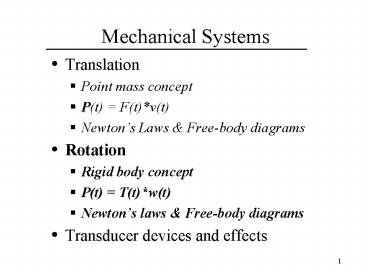Mechanical Systems - PowerPoint PPT Presentation
Title:
Mechanical Systems
Description:
Translation Point mass concept P(t) = F(t)*v(t) Newton s Laws & Free-body diagrams Rotation Rigid body concept P(t) = T(t)*w(t) Newton s laws & Free-body diagrams – PowerPoint PPT presentation
Number of Views:33
Avg rating:3.0/5.0
Title: Mechanical Systems
1
Mechanical Systems
- Translation
- Point mass concept
- P(t) F(t)v(t)
- Newtons Laws Free-body diagrams
- Rotation
- Rigid body concept
- P(t) T(t)w(t)
- Newtons laws Free-body diagrams
- Transducer devices and effects
2
Mechanical rotation
- Newtons Laws (applied to rotation)
- Every body persists in a state of uniform
(angular) motion, except insofar as it may be
compelled by torque to change that state. - The time rate of change of angular momentum is
equal to the torque producing it. - To every action there is an equal and opposite
reaction. - (Principia Philosophiae, 1686, Isaac Newton)
3
Quantities and SI Units
- F-L-T system
- Define F force N
- Define L length m
- Define T time s
- Derive
- T torque (moment) N-m
- M mass kg
- w angular velocity rad/s
- J mass moment of inertia kg-m2
4
Physical effects and engineered components
- Inertia effect - rigid body with mass in rotation
- Compliance (torsional stiffness) effect
torsional spring - Dissipation (rotational friction) effect
torsional damper - System boundary conditions
- motion conditions angular velocity specified
- torque conditions - drivers and loads
5
Rotational inertia
- Physical effect ?r2?dV
- Engineered device rigid body mass
- Standard schematic icon (stylized picture)
- Standard multiport representation
- Standard icon equations
6
Rigid body in fixed-axis rotation standard form
J
T1
T2
7
Compliance (torsional stiffness)
- Physical effects ?E?
- Engineered devices torsional spring
- Standard schematic icon
- Standard multiport representation
- Standard icon equations
8
Torsional compliance
w1
w2
T
9
Dissipation (torsional resistance)
- Physical effects
- Engineered devices torsional damper
- Standard schematic icons
- Standard multiport representation
- Standard icon equations
10
Torsional resistance
w1
w2
T
11
Free-body diagrams
- Purpose Develop a systematic method for
generating the equations of a mechanical system. - Setup method Separate the mechanical schematic
into standard components and effects (icons)
generate the equation(s) for each icon. - Standard form of equations the composite of all
component equations is the initial system set
select a reduced set of key variables
(generalized coordinates) reduce the initial
equation set to a set in these variables.
12
Multiport modeling of mechanical translation
- Multiport representations of the standard icons
focus on power ports - Equations for the standard icons
- Multiport modeling using the free-body approach
13
Multiport modeling of fixed-axis rotation based
on free-body diagrams
- Identify each rotating rigid body.
- Define an inertial angular velocity for each.
- Use a standard multiport component to represent
each rotating rigid body (with or without mass). - Write the standard equation(s) for each
component.
14
Example 1 torsional system































